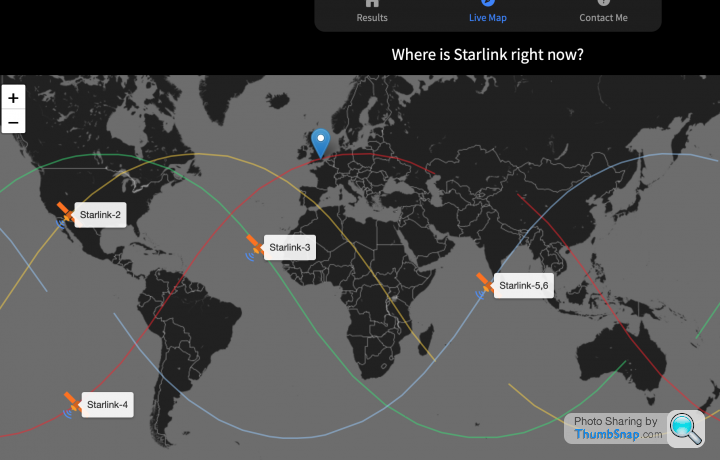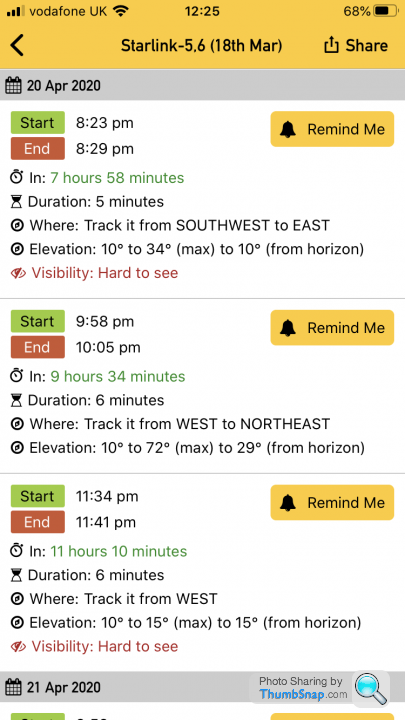Starlink satellites - visible passes
Discussion
Shuvi McTupya said:
GloverMart said:
The earlier one this evening was the best one yet and there's another one around 11pm tonight. .
Did this happen?I have a pretty decent view to the SW (from the Midlands) and poked my head out for a few minutes around 11pm but didnt see anything apart from stars 
There is supposed to be a cracking one tonight around 9.55pm, as good as the early one was last night.

Eagleye said:
Apologies for my ignorance but why isn't Starlink geostationary (or is the word geosynchronous).
It's complicated but Lower Earth Orbit (LEO) is more cost effective to launch and in theory less affected by latency. The issue that you have with this is that you need to launch hundreds/thousands of them to cover the earth service. In a more conventional geostationary orbit, three satellites will do the same job.The second issue is how they will get the ground stations/terminals to work correctly with all of these satellites, for example a transatlantic jet will only have to communicate with one geostationary satellite but multiple LEO ones, doesn't sound complicated but it actually could be and I'm not convinced they've mastered it just yet.
Not that they won't/can't but the more established sat comms operators already have this set up. I do work in the industry but not a techie role so the intricacies of what I might be saying might be a bit rough around the edges, but somewhere in the above is a valid point

The best passes (as with the ISS) are probably those not long after dusk with sun reflection still possible - 11pm may be too late currently.
This site, posted on another thread, suggests 10pm tonight, and then 9pm tomorrow looks like it may be even better?
https://james.darpinian.com/satellites/
This site, posted on another thread, suggests 10pm tonight, and then 9pm tomorrow looks like it may be even better?
https://james.darpinian.com/satellites/
This site/app works well
https://findstarlink.com/#1529;3
& comes with a train tracker
https://findstarlink.com/#1529;3

the app also gives you details of the fly overs. (From my location).

https://findstarlink.com/#1529;3
& comes with a train tracker
https://findstarlink.com/#1529;3

the app also gives you details of the fly overs. (From my location).

-crookedtail- said:
Eagleye said:
Apologies for my ignorance but why isn't Starlink geostationary (or is the word geosynchronous).
It's complicated but Lower Earth Orbit (LEO) is more cost effective to launch and in theory less affected by latency. The issue that you have with this is that you need to launch hundreds/thousands of them to cover the earth service. In a more conventional geostationary orbit, three satellites will do the same job.The second issue is how they will get the ground stations/terminals to work correctly with all of these satellites, for example a transatlantic jet will only have to communicate with one geostationary satellite but multiple LEO ones, doesn't sound complicated but it actually could be and I'm not convinced they've mastered it just yet.
Not that they won't/can't but the more established sat comms operators already have this set up. I do work in the industry but not a techie role so the intricacies of what I might be saying might be a bit rough around the edges, but somewhere in the above is a valid point

.......

.......
.......latency.
600ms for geostationary - Starlink in the 20ms - 30ms region, at least that's what they're saying.
In simple terms, because geostationary satellites are so high up (over 22,000 miles), the radio signal has to take a 44,000 mile trip from the transmitter to the receiver. This creates a noticeable time delay in any real time communications - which can be very annoying.
A low orbit (under 400 miles) reduces this time delay to virtually nothing.
The problem with low orbiting satellites is that they are only above the horizon from any one location on earth for a few minutes - so you need dozens of the things to be whizzing about over your head so you have continuous contact with the system.
A low orbit (under 400 miles) reduces this time delay to virtually nothing.
The problem with low orbiting satellites is that they are only above the horizon from any one location on earth for a few minutes - so you need dozens of the things to be whizzing about over your head so you have continuous contact with the system.
GloverMart said:
Sambucket said:
Shooting stars on demand. Could catch on.
Couldn’t X make them less reflective?
Think the next batch being built will be more reflective, that's the idea. The whole thing causes astrophotographers a world of problems taking good pics with these things whizzing around the skies....Couldn’t X make them less reflective?
Sambucket said:
You can’t paint them black then?
Things are never as simple as you might think. They are intending to reduce the reflectivity of these satellites. In fact, the most recent launch a few weeks ago had some of the satellites with the low reflectivity exterior.However, simply painting a spacecraft or satellite black would create all sorts of other issues. One of the biggest headaches for a spacecraft or satellite designer is keeping the internal temperature of the craft within reasonable limits. It's very easy for a spacecraft to overheat - so painting it black would pretty much cause its internals to cook - possibly within a few hours of launch.
If you look at satellites, you will see they have different colours or materials applied to panels and a lot of this is in order to maintain the internal temperatures at levels which ensure the satellite keeps functioning.
Sambucket said:
GloverMart said:
Sambucket said:
Shooting stars on demand. Could catch on.
Couldn’t X make them less reflective?
Think the next batch being built will be more reflective, that's the idea. The whole thing causes astrophotographers a world of problems taking good pics with these things whizzing around the skies....Couldn’t X make them less reflective?
eharding said:
600ms for geostationary - Starlink in the 20ms - 30ms region, at least that's what they're saying.
Sounds about right but don’t forget 600ms is the one way time, you need the signal to go up and back, then it lands in a ground station which might be in a different country to the final destination, so it’s more like 1.5-4 secs of latency end to end and that’s with one end on the ground. If both are satellite connected then you might be going up and back four times...Usable for phone calls but takes a bit of getting used to! Also data rates struggle over high latency connections, there’s some fairly cunning tricks to help but is still limited.
Gassing Station | Science! | Top of Page | What's New | My Stuff


